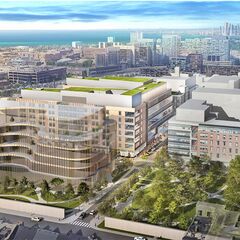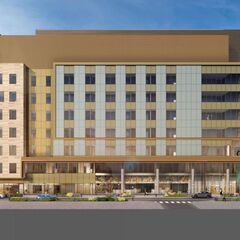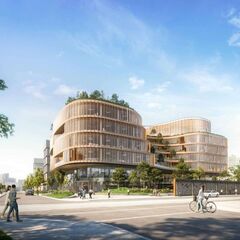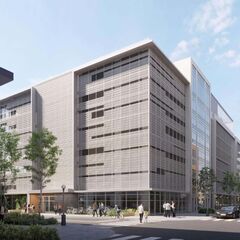JBM in Canadian Architect
Link to article
Mind Over Matter
With Each Generation, Designing the Optimum Mental Health Care Facility Presents a Unique Set of Challenges. The latest Incarnation of Toronto's Camh Raises Numerous Questions Regarding Ethics, Planning and Development.
PROJECT CENTRE FOR ADDICTION AND MENTAL HEALTH, REDEVELOPMENT PHASE 1 (1A & 1B), TORONTO, ONTARIO
ARCHITECT THE C3 COMMUNITY CARE CONSORTIUM: KUWABARA PAYNE MCKENNA BLUMBERG ARCHITECTS, MONTGOMERY SISAM ARCHITECTS INC., KEARNS MANCINI ARCHITECTS LTD., IN JOINT VENTURE
TEXT JOHN BENTLEY MAYS
The sweeping $382-million re-creation of Toronto's Centre for Addiction and Mental Health (CAMH), in progress on the facility's historic site on Queen Street West, is an undertaking at a scale unprecedented in the history of Canadian psychiatric hospitals. But size and complexity are only parts of what makes the CAMH story unique. More important are the remarkable architectural ambitions of the project: to purge from the site all reminders of psychiatry's often dark past, and to translate into steel, brick and streetscape the most advanced contemporary thought about the nature of mental illness and its treatment.
"We are right at the cutting edge," says CAMH director and CEO Dr. Paul Garfinkel. "People need to be treated in a respectful, dignified, holistic manner that sometimes requires them to be confined in a hospital voluntarily or involuntarily. The more we normalize the hospital stay, in keeping with safety and security, the better it is for the person's recovery, and ultimate reintegration. Normalizing starts with an urban village, like the rest of the city, but it gets into the nature of public space, treatment space, what our hospital rooms look like. We want to make [the hospital] a more homelike setting, just as you would want in a normal community." Dr. Garfinkel is especially critical of the "biological reductivism" fashionable in psychiatry for the last 30 years, a theory that lays great emphasis on medication--often, he believes, at the expense of the patient as a whole person, and at the expense of the settings of his treatment.
Between now and 2018, almost all built vestiges of the 157-year-old psychiatric institution will be erased. Only two small utility buildings and what remains of the once-forbidding perimeter wall (by the Toronto firm Cumberland & Ridout, and city architect Kivas Tully) will survive from Victorian times. A forensic unit constructed in the 1970s will also remain, at least until its demolition sometime after 2018. According to the award-winning master plan crafted by George Dark and Frank Lewinberg of the Toronto firm Urban Strategies, the isolated 27-acre campus will be diced into nine city blocks by the extension of existing streets, and much of the existing green space will be buried under development.
The mid-rise buildings that will appear on these new urban blocks--designed by a consortium of the three Toronto offices of Kuwabara Payne McKenna Blumberg, Montgomery Sisam, and Kearns Mancini--will house CAMH's patients, doctors and staff, as well as a host of non-CAMH services. While the exact nature and placement of the non-hospital uses have yet to be determined, a grocery store and health club, scientific institutes and laboratories, cafés and private residences have been mentioned.
In a further bid to realize Dr. Garfinkel's "urban village," and to eliminate the ancient stigma attached to monolithic, purpose-built asylums in secluded parks, the treatment of the ill will be handled at points scattered among the non-CAMH structures. The long, homely, three-storey administration and patient-care building by Mathers & Haldenby, which has dominated the Queen Street face of the institution since 1956, will vanish, to be replaced by a streetscape intended to harmonize with the neighbourhood's traditional fabric of small shops, restaurants, galleries, single-family homes and apartment buildings. The Workman Theatre, a space much loved by local residents and others throughout the city, will also disappear, though plans call for a new theatre to be built on Queen Street.
"We are taking a pioneering approach, trying to pull out of the traditional hospital model," says Terry Montgomery, of Montgomery Sisam Architects. "We want to break it down, and integrate the hospital with the city--make it a transition to the city, daily training to go back to the city." Quoting team architect Bruce Kuwabara, Montgomery said, "CAMH will be European scale, with Toronto identity."
A sample of what Montgomery and his architectural colleagues have in mind for CAMH's mixed-use development broke ground on the western edge of the site last autumn. Due for completion in early 2008, this $35-million construction phase on the new Fennings Street extension features a four-storey outpatient treatment facility, and three buildings designed to contain what CAMH calls "alternative milieu" dwellings: 72 motel-like rooms, with private washrooms and lockable doors, for patients who still need hospital care, but who have progressed beyond the acute stage of their illnesses.
According to Montgomery, the exteriors of these buildings will present a time-honoured image to the city beyond, with cladding in Toronto's Victorian red and buff brick, big bay windows and "recognizable porches." The architectural treatment of future buildings (which range in height between six and eight storeys) will likely change over the 11-year construction life of the project. But the basic thrust of the design is probably apparent in the earliest phase: contextual in styling and material palette, retiringly modernist, and more or less uniform, in accord with CAMH's decision to mute the visual difference--along with every other difference--between hospital facilities and non-hospital buildings.
The architectural strategy at the heart of the CAMH development has a venerable pedigree going back to the neighbourhood urbanism of Jane Jacobs, and to hospital reformers determined to see once-aloof institutions stitched more tightly into the fabric of urban life and structure. But the CAMH scheme is also part of the special history of asylum design, which has always reflected, with sometimes startling quickness and directness, the prevailing psychiatric wisdom of its era.
In early 19th-century Britain and North America, for example, democratic and populist tendencies in the culture at large led to drastic changes in official attitudes toward the insane. A new psychiatric elite, disgusted by the old regime of chaining the mad in dangerous prisons and filthy dungeons, called for a new hospital architecture to express the spirit of the times: open to fresh air and sunlight, in peaceful rural settings, from which cruelty and neglect had been banished in favour of good diet, sensible recreation and humane, individual care of the ill.
In 1846, when its cornerstone was laid, architect John George Howard's Neoclassical Provincial Lunatic Asylum--the first building on the present-day CAMH site--promised to be a great architectural incarnation of this new idea in psychiatry. Over the next few years, its walls and long galleries rose on a marshy plot reclaimed from the Fort York military reservation, in the still-sylvan countryside along Queen Street West. Howard's structure opened in 1850.
The early optimism about Howard's building, and the therapy it symbolized, were soon dimmed by overcrowding and, especially in the later 19th century, by a generally gloomy recognition that the mental disorders that doctors purported to treat were more intractable and insidious than an earlier generation of fresh-air physicians had believed. And not far beneath the troubled surface ran a question of class: early Victorian avant-garde psychiatrists, trained to treat maniacs from genteel, literate and religious backgrounds, were suddenly confronted by waves of seriously disturbed people thrown into the medical system by immigration, industrialization and urbanization, the resulting obliteration of the extended rural family, and by other vast social upheavals of the time.
By the 1970s, Howard's asylum was widely hated by patients, doctors and ordinary Torontonians. It had come to symbolize the most ghastly aspects of past psychiatry--the overcrowding, restraint and heroic treatment by surgery and severe drugs. But by then, new ideas of treatment were in the air--the "deinstitutionalization" of mental patients, and devolution of healing from large centralized hospitals into smaller units embedded in the old institution's campus or within the community. In 1976, the last remnants of Howard's asylum fell under the wrecker's ball after a conflict between architectural preservationists championed by Toronto architect A. J. Diamond, and a psychiatric and political establishment determined that the hospital must go. In its place rose four treatment units (by Somerville, McMurrich & Oxley), which seemed to observers at the time and since to resemble college dormitories dotting a suburban campus.
All four of these towers are to be bulldozed eventually. It's worth noting that these buildings, now doomed, were much admired when they were completed. In a 1975 article in The Canadian Architect about the just-finished project, we read about the delight of patients and staff with the new facilities' comfort, beauty and modernity. All that cheerfulness was in sharp contrast to their attitudes toward John George Howard's 1850 structure. "Their comments centred around its atmosphere of hopelessness, its resemblance to a jail and its depressing effects on their feelings."
One should be forgiven a certain thrill of schadenfreude upon finding Dr. Paul Garfinkel quoted in early 2007 in the Toronto Star, declaring that "the existing buildings"--viz., the '70s units that pleased so many--"are unacceptable in the 21st century of health care; they are cramped, undignified, disrespectful of the needs of individuals, and hardly inspiring of hope." So what makes CAMH sure they're not casting into brick and mortar merely the newest fad in psychiatry in the cycle of "breakthroughs" and disappointments that has been ongoing since the early 19th century?
They are not sure, Dr. Garfinkel told me. Hence, the plan to make each new structure architecturally generic, undedicated to a single use dictated by current medical ideas. "What we need in 2010 may very well not be the same in 2040. Our buildings are going to be flexible, because programming is going to change as understanding changes. I would be delighted about that, because it would indicate we are making progress rather than spinning."
Others are not so sure this development is a good thing. While the "urban village" is fixed in contemporary planning and architectural orthodoxy, the penetration of the CAMH campus by local streets and normal street life has drawn criticism from within the medical community. Dr. Patricia Cavanagh, a psychiatrist at Toronto Western Hospital who is familiar with CAMH, rues "the loss of an old-fashioned sense of asylum. That's the thing I am sorry to see go. Bringing traffic through will change the culture of the place, and this great green site will be gone. That's what I am mourning. You have severely ill people who are stigmatized by their absurd movements and expressions, and are avoided. But [the present CAMH facility] is one place where they are totally accepted."
Still other complaints have been levelled at the hospital by its neighbours along Queen Street West. In 2003, a coalition of patient activists, business and private opponents hauled CAMH before the Ontario Municipal Board (OMB)--a quasi-judicial body with wide-ranging powers over planning throughout the province--demanding (among other things) greater transparency by the hospital, studies of the development's impact on the cultural and natural environment, and building heights that harmonize with Queen Street's Victorian streetscape. "There was a lack of flow of information between CAMH and residents and stakeholders," says Sasha Jarh, a vocal member of the citizens' group. "Nobody knew what exactly would be built."
For corporate lawyer and local resident Peter Aziz, who led his neighbours' fight to the OMB, the hospital's insensitivity and lack of concern for local opinion is best symbolized by CAMH's proposal for a 50,000-square-foot grocery store on Queen Street. "It would have been completely out of proportion to the dynamic Queen West neighbourhood, which is comprised of small businesses and houses." Largely due to that new dynamism--the area is a strong focus of real-estate activity--CAMH is sitting on very valuable land, some of which will likely be sold to development partners over the next few years. "[CAMH] is quite prepared to sell out the neighbourhood for a fast buck," Aziz said.
In the OMB settlement eventually hammered out between the coalition and the hospital, most concerns were addressed to the satisfaction of the community group, said Stephen Bulger, owner of an important local photography gallery and an appellant in the OMB case. The size of the proposed grocery store was cut. A top-level site review committee was established with representation from local residents and businesses, to help open the massive process of renovation to public scrutiny. Peter Aziz thinks the hospital's recent move toward greater transparency is a "sham."
In fairness to those critical of the hospital's opacity--and while I did not sense any skulduggery on the part of the hospital--it should be said that there is indeed an air of mystery about this development. Nobody, not even CAMH administrators or the architects, could tell me exactly what will be built, and where, over the next decade. I think they do not know. Urban Strategies' master plan only goes so far as to divvy up the site between the hospital and other uses, which comes out to 50 percent for each. General guidelines for non-CAMH uses were established only in January of this year. Now the hunt begins for commercial and institutional tenants and development partners prepared to set up shop in a very stylish part of town, but in a complex largely populated by the mentally ill, many of them poor and some very sick. It promises to be a daunting task--a lot harder than, let's say, tucking a spiffy boutique into a cardiac ward.
The CAMH project is a bold experiment that will surely have strong impacts, some of which cannot be clearly foreseen--on the city, the life of its immediate community, and the lives of patients. The neighbours and patients have every right and reason to be concerned, especially now, when the precise future of the hospital is uncertain. But even for skeptics, it will be fascinating to watch the Centre for Addiction and Mental Health as it slowly rolls out toward the future over the next several years.
John Bentley Mays is an architecture critic and writes regularly for The Globe and Mail.
CLIENT CENTRE FOR ADDICTION AND MENTAL HEALTH
ARCHITECT TEAM TERRY MONTGOMERY, JONATHAN KEARNS, BRUCE KUWABARA, ALICE LIANG, SAFDAR ABIDI, BILL COLASSO, ROBERT D'ERRICO, JOSE EMILA, CARSON FUNG, MARK JAFFAR, CHRISTINE LEU, DAN MCNEIL, LESLIE PARKER, EMMANUEL RESENDES, JAVIER ZELLER, GARTH ZIMMER
STRUCTURAL READ JONES CHRISTOFFERSEN LTD.
MECHANICAL RYBKA, SMITH AND GINSLER LIMITED/MMM GROUP
ELECTRICAL CROSSEY ENGINEERING LTD.
LANDSCAPE JANET ROSENBERG ASSOCIATES LANDSCAPE ARCHITECTS
FACILITIES PLANNING CONSULTANT RESOURCE PLANNING GROUP INC.
PLANNING AND URBAN DESIGN URBAN STRATEGIES INC.
CONTRACTOR EASTERN CONSTRUCTION (PHASE 1A)
AREA 628,700 FT2
BUDGET: $180 M
COMPLETION PHASE 1A--EARLY 2008; PHASE 1B--2012

























